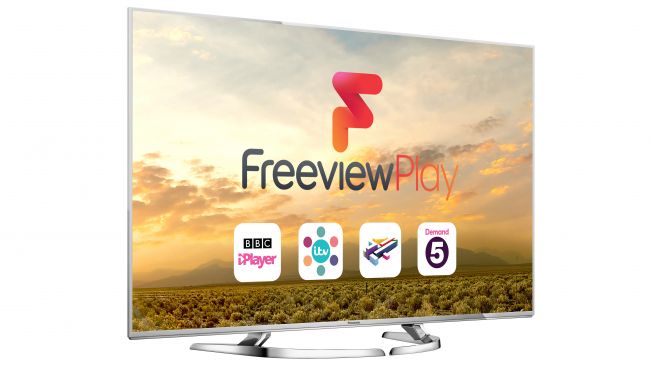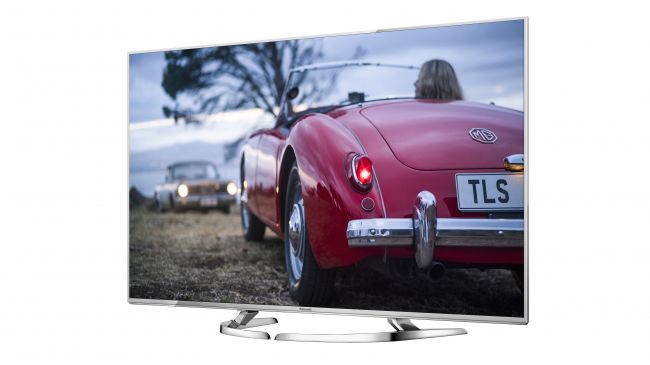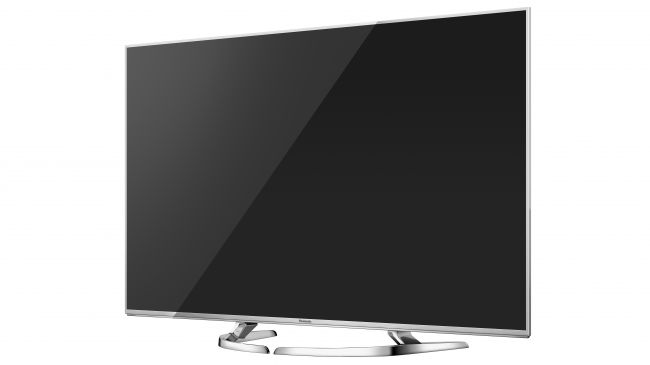
No sooner have we got used to talking about 4K Ultra HD TVs than another potentially game-changing feature has come along. Called high dynamic range (HDR), this new feature introduces more brightness and colour to pictures and it’s complicated and challenging from a technological point of view, but also, completely capable of transforming your TV viewing experience.
Despite only costing $1,299, the Panasonic 50DX750 supports HDR as well as squeezing 4K’s 3840×2160 resolution into its 50-inch screen. So, on paper at least, it’s a hugely appealing prospect for AV fans looking for a future-proof TV solution that doesn’t cost the earth.
While your eyes might focus on the screen, the DX750’s design catches the eye in all the right ways, too. Its slender frame boldly eschews the current penchant for blackness in favour of a glinting silver finish that combines simplistic harmony with the innovative desktop stand design.
This stand can be fitted in no less than four different ways according to your tastes and needs. The legs can have their curved parts facing forward and their sharp bits facing back or vice versa, and they can be fitted either towards the centre of the screen or at its extreme corners. It’s not quite a bespoke solution, but any sort of customisation is appreciated.

Spin the 50DX750 around and it looks just as good. It delivers four HDMIs, for starters, when I’d only expected to find three given how affordable the set is for the technology it offers. Two of these HDMIs support the HDCP 2.2 anti-piracy protocols and 60/50Hz 4K playback of the latest HDMI standards.
There are also three USBs for playing back a good selection of photo, music and video multimedia files or recording from the TV’s Freeview HD tuner to a USB HDD. Plus you get the now inevitable integrated Wi-Fi and Ethernet network options.
The Wi-Fi/Ethernet options include streaming from any external DLNA-capable devices you may have on your network, as well as brokering a connection with your smart devices for sharing content from them or controlling the TV through them via Panasonic’s TV app.
It’s got the smarts
The network options also, of course, enable the 50DX750 to connect with Panasonic’s ring-fenced world of online content (or explore the World Wide Web if you really want to).
This content is reasonably expansive now that Panasonic has ditched its old proprietary online system in favour of a version of Mozilla’s Firefox system specially designed for TV use.
As usual, though, I found during my tests that I only really used a handful of the available apps, chiefly those built for video streaming – in particular Netflix and Amazon, which are here provided in their 4K streaming incarnations. It’d be nice to see a more diverse crowd of apps, but what’s here will suffice for video streaming.
The 50DX750 is also equipped out of the box with the Freeview Play catchup TV platform that lets you stream shows you might have missed from all of the TV’s ‘big four’ broadcasters. You can even search for such content using an electronic programme guide that covers the past seven days of the TV schedules as well as the next seven.
Perhaps the single best thing about the 50DX750’s expansive and useful set of smart features, though, is that they are all martialled through Firefox’s excellent onscreen menu system.

This is an attractive, sensibly organized and intuitive way about focusing on the sort of content most TV users want while keeping it easily customisable. It’s a genuine rival for LG’s excellent webOS interface and the perfect foil to the overbearing clutter of Android TV.
I’ve already mentioned the 50DX750’s key screen features of a native 4K UHD resolution and support for the new high dynamic range (HDR) format. But the latter needs more explanation. HDR isn’t binary – it’s not as simple as saying “yes it has it,” or “no it doesn’t” – we’re also dealing with the level of HDR performance it delivers.
Check the specs
For instance, while Panasonic’s first TV of 2016, the 65DX902, met the so-called ‘Ultra HD Premium’ specifications for 4K HDR recommended by the AV industry’s Ultra HD Alliance, the 50DX750 does not. And it falls short for multiple reasons.
First, it’s only an 8-bit screen, not a 10-bit one. Some would argue that this makes it debatable if the screen can even be called an HDR one, but I don’t subscribe to that view for the simple reason that when it receives an HDR source the 50DX750’s images clearly enjoy a signficant colour ‘uplift’ from the way they look with standard dynamic range content.
The 50DX750 also doesn’t hit the 1000 nits of brightness required to meet the Ultra HD Premium recommendations. But before you call Panasonic an outright liar, the DX750 does still use bright panel technology that makes it comfortably brighter than the 350-500 nits you generally get from TVs that don’t support HDR.

On the colour side of things, Pana’s latest still uses wide colour gamut phosphors to help it cope with the expanded colour range associated with almost all the HDR content we’re seeing (though it doesn’t deliver as much of the DCI-P3 digital cinema colour space as the 65DX902 does), while a degree of local dimming applied to its edge LED lighting engine should help the screen produce the sort of extreme contrast range HDR playback demands.
While I’m on the subject of HDR and colour, I should point out that 50DX750 does not support the Dolby Vision HDR system. In fact, the only brand in the UK supporting Dolby Vision right now is LG, with its imminent SuperUHD LCD and new OLED TVs.
It’s not all bad, though. The 50DX750’s picture quality will hopefully benefit from the set’s powerful ‘Studio Master HCX’ video processing engine. This delivers, among other advantages, a reported 1800Hz motion effect (delivered via a combination of frame interpolation and backlight manipulation) that should keep LCD’s issues with motion blur and judder to a minimum.
Another advantage is that it also delivers extremely careful control over the image’s colour and light elements. In practice that means that the DX750 attempts to deliver pictures that look as close as the TV can get to the way their creators intended them to look. This ‘director’s intention’ aim applies to both HDR and SDR content, though there are various ‘remastering’ circuits on hand to try and bring SDR up to the something approaching HDR if that appeals to you.
The 50DX750’s picture circuitry has been developed with the assistance of Panasonic’s Hollywood Laboratories. However, unlike the DX902 this mid-range model, it doesn’t boast a picture preset calibrated by colourist Mike Sowa, or THX certification.
One last key feature of the 50DX750 is its 3D playback ability. This uses the full HD active solution, and takes on extra significance this year given that both Philips and Samsung have announced that none of their 2016 models will support 3D. The bad news? You don’t get any free active shutter glasses with the TV.
For much of the time the images on the 50DX750’s screen look nothing short of beautiful, punching well above the set’s price point. In fact, even if you only use it with standard dynamic range content, the set sits comfortably in ‘best buy’ territory.
It’s one of the few instances where, once you’ve reduced the 50DX750’s backlight setting considerably – potentially to around a third of its maximum level if you’re watching a film in a darkened room – standard dynamic range Blu-rays and HD broadcasts benefit from a terrific black level response for such an affordable but well-featured TV.
Being able to deliver an impressively true black colour relatively untarnished by the grey mist effect you get with pretty much all edge-lit LCD TVs, to some extent, makes dark scenes look believable, immersive and much more consistent with bright ones when it comes to tone and depth.
What’s more, so long as you’ve followed the earlier advice regarding the backlight setting, the impressively rich, deep blacks are delivered with strong consistency right across the screen, with only the very faintest traces of the backlight clouding problems many edge LED TVs suffer from.

Even better, the really impressive black levels are delivered without coming at the usual cost of lost shadow detail in the darkest areas. I can’t think of another LCD TV brand that’s quite as good as Panasonic at retaining tiny bits of luminance and colour information in dark areas – a testament, in part at least, to the excellent processing systems Panasonic has delivered for the past few years.
The same deftness of touch is apparent with the 50DX750’s handling of colours when showing standard dynamic range content. So good is it at picking out the slightest tonal shifts, balancing the whole colour palette and making colours always look natural and believable, that it’s hard to believe it’s using an 8-bit panel. It’s impressive to see, too, that the 50DX750 is able to deliver all these subtle colour traits while still delivering rich saturations and plenty of vibrancy.
In other words, the 50DX750 seems to put some of the hardware and software developed for HDR to good use in enhancing SDR, without leaving the latter looking in any way unnatural.
Impressive clarity and colour
Having such pristine control over its light and colour performance also helps the 50DX750 deliver a good sense of 4K UHD’s clarity and detailing, despite some marginal motion blur taking the edge off things when there’s a lot of motion in the frame. Actually, the 50DX750 delivers a fine sense of sharpness and texture with HD sources too, thanks to an excellent upscaling performance.
This same processing engine also does a surprisingly decent job of the actually very difficult task of trying to convert SDR footage to something approaching HDR via assorted remastering options.
The way the set can expand SDR’s colour range without images starting to look unnatural or forced is particularly impressive. Having said all that I’d probably still avoid the remastering circuitry with most SDR sources, and leave the TV’s HDR capabilities to genuine HDR sources.
Speaking of which, in many ways the 50DX750’s HDR performance is better than I’d expected given that it makes no claim to deliver HDR to the standard recommended by the UHD Alliance.
Feeding the TV an array of Ultra HD Blu-rays reveals a comfortably more expansive colour range than you get with SDR versions of the same movies, and there’s also an expanded sense of contrast, with slightly deeper blacks and clearly brighter light peaks.

The general brightness level of some HDR scenes is higher too, though the 50DX750’s edge LED engine doesn’t score as well in this general HDR brightness department as the direct-lit DX902 models.
Also good to see is how well the 50DX750’s processors remap HDR images to the screen’s sub-1000 nit brightness capabilities, as it largely ducks the lost shadow detail, unnatural colours and flared-out white areas issues you can get with less astute remapping systems.
In keeping with many other 2016 HDR TVs, though, the 50DX750’s HDR abilities come up a bit short during dark scenes – or, more specifically, dark scenes that contain a few bright highlights.
The issue is simply that you can clearly see a band of light running down the picture around any bright objects during dark HDR scenes when using the TV’s optimised HDR settings.
A smaller HDR distraction sees the image’s overall brightness flitting up and down a bit distractingly when you’ve got the TV’s Adaptive Contrast feature selected. Yet, if you turn this feature off, overall black levels take a significant hit I suspect most users won’t want to put up with.

There are mitigating circumstances with the 50DX750’s HDR dark scene issues. For a start, they aren’t as consistently obvious if you’re watching TV in a reasonably bright room. They’re also less obvious if what you’re watching has a roughly 16:9 aspect ratio, so that there are no black bars above or below the picture. Finally, you can reduce the obviousness of the backlight flaws if you reduce the backlight setting when watching HDR content.
However…
For me, though, HDR movies are actually made for dark room viewing at least as much as SDR movies are. Also, the vast majority of popular movies are made with aspect ratios that require the addition of black bars above and below them. And, finally, the more you reduce the TV’s brightness output the more you’re reducing the TV’s HDR impact and accuracy.
It’s important to stress that HDR playback thrills on the 50DX750 far more than it aggravates. So much so that many may consider the dark scene backlight flaws a fair price to pay for all the good stuff. But movie fans who hate ever being distracted out of what they’re watching could well find the HDR backlight issues at least a little frustrating.
The 50DX750’s 3D performance, finally, is sadly pretty uninspiring. While the screen’s brightness and colour richness serve it well in countering the dimming effects of active shutter glasses, 3D images suffer with quite significant amounts of crosstalk ghosting. This reduces the sharpness of 3D images and makes them quite tiring to watch.
The 50DX750 is a mixed bag where day-to-day use is concerned. On the plus side, the Firefox-based smart TV interface is outstandingly easy to use thanks to the way it lets you build your own ‘home page’ and streamlines access to the most useful apps.
The TV’s set up menus, on the other hand, are a bit tortuous to navigate and feature some quite complicated but not brilliantly well explained features. Plus, you’ll almost certainly need to familiarise yourself with at least some of the picture set up features if you want to consistently get the best picture quality from your 50DX750.
Sound quality and value
For such a slim, airy design the 50DX750 produces a pretty satisfying sound performance. Male and female voices alike sound clear and well rounded even during action scenes, the speakers are ‘hi-fi’ enough to deliver lots of detail from high-quality movie and TV show mixes, and there’s enough power on tap to avoid the sense of thinness and harshness you often hear with action scenes on ultra-slim TVs.
Voices and effects sound like they’re coming from the right place on screen too despite the set’s speakers actually firing downards rather than directly forward.
The 50DX750 doesn’t deliver the same aggression and dynamics you get from TVs that do use forward firing speakers, but overall the 50DX750 sounds better than I would have expected for its size and money.

Despite its flawed HDR performance, the 50DX750’s picture quality looks far more impressive for most of the time than you’ve any right to expect for its money.
It’s well featured for a $1,300 50-inch UHD TV too, and its smart engine shames those of some TVs costing thousands of pounds more.
The 50DX750 scores big on shelf appeal. Its $1300 price is aggressive for a TV that supports both a native 4K UHD resolution and high dynamic range playback, its adjustable design is a breath of fresh air, and its smart TV system is both eye-catchingly attractive and a dream to use. For the most part it backs this initial attraction up with its picture and sound performance too, only coming up a little short when it comes to handling HDR’s most extreme content.
We liked
The 50DX750’s glinting, barely-there chassis and adjustable stand design look handsome in any room design, and it’s well connected for today’s 4K, HDR world. Its picture quality is capable of looking excellent for most of the time too, and we’re a big fan of its Firefox operating system. It’s strong value too.
We disliked
If you’re watching a dark HDR scene that has some bright highlights in it, you can see some pretty clear light ‘striping’ down the picture. There’s also some more generalised backlight clouding with SDR content unless you reduce the backlight considerably.
Verdict
Although the 50DX750’s difficulties handling dark high dynamic range scenes remind you that we’re still at the frontier of HDR playback, the technologies the set introduces to aid its HDR playback also deliver across-the-board SDR picture quality improvements that make Panasonic’s aggressively priced mid-range TV a great value option. Especially if you’re not prone to dark room viewing and so are less likely to be troubled by the occasional backlight issue.
Source: techradar.com









































